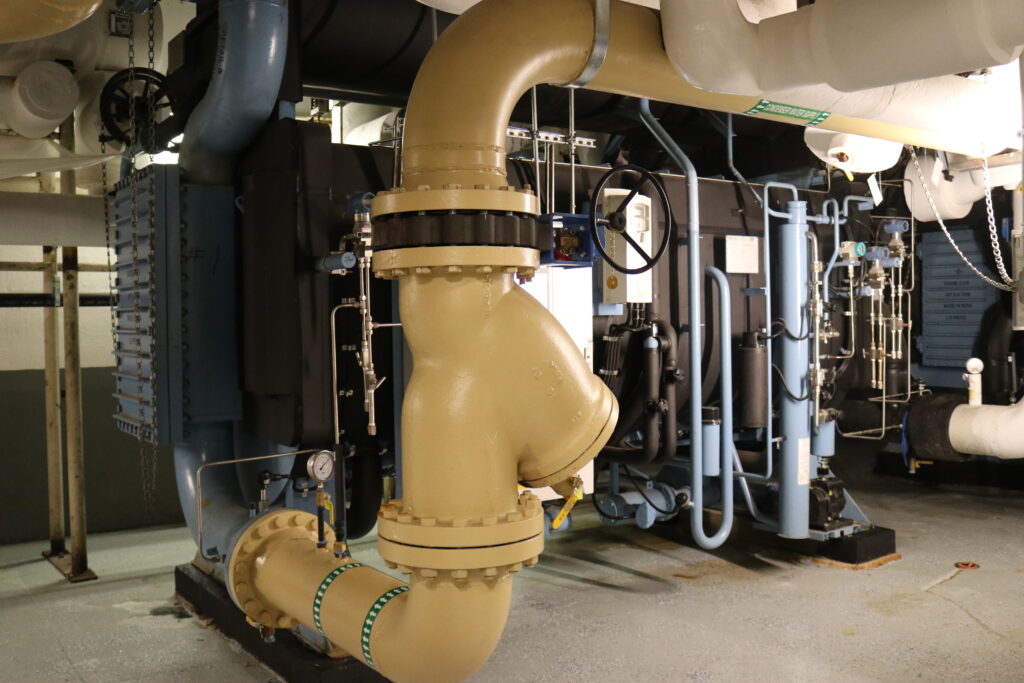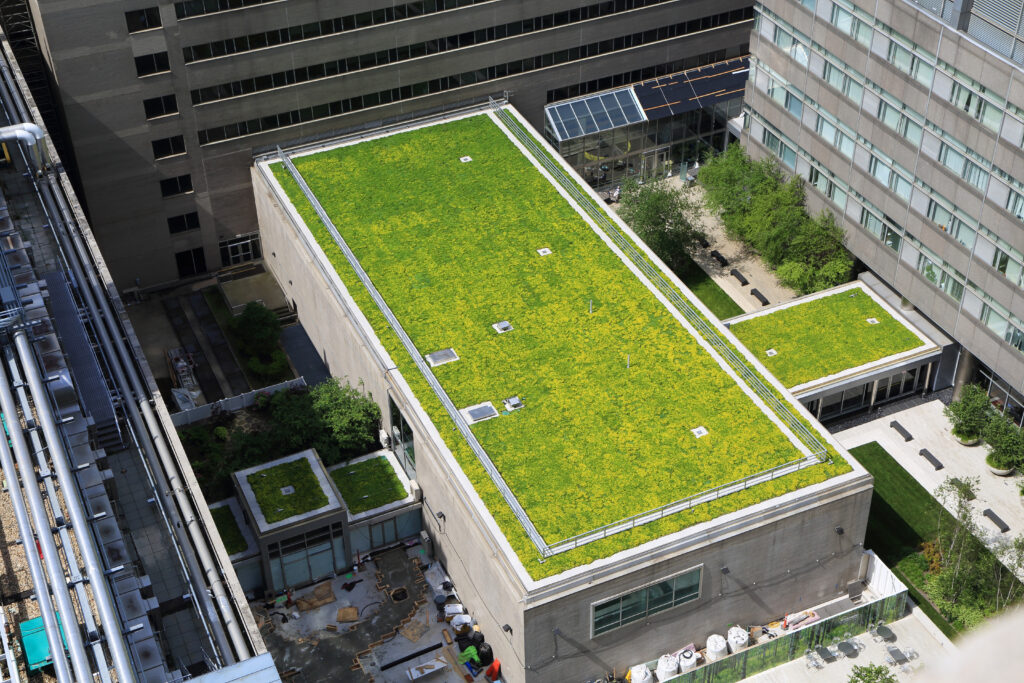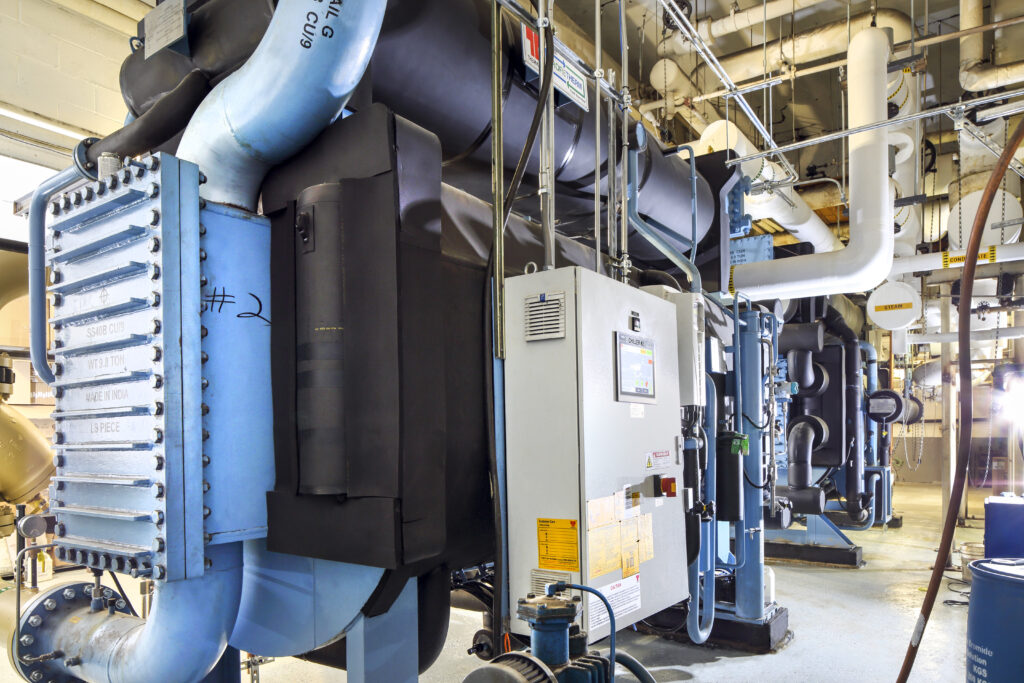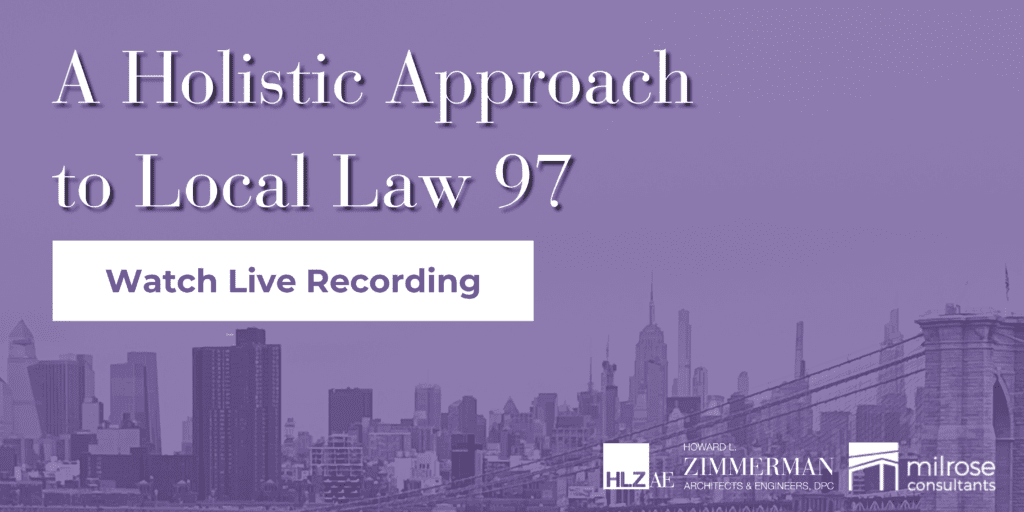Local Law 97: You asked, we answered…
May 21, 2024
A Holistic Approach to Local Law 97: FAQs
We’ve recently conducted a live webinar discussing the details of Local Law 97. Recognizing its significance and the common inquiries we receive; we’ve compiled responses from our in-house experts to address the most frequently asked questions.
As a reminder, the 2024 emissions report is due on May 1, 2025. It’s crucial to begin your preparations now to ensure compliance with Local Law 97’s requirements.
If you missed any part of the webinar or would like to revisit the information, you can access the recording through the button below.
Below you’ll find a list of the most commonly questions we’ve received and our answers to them.
- Is NYS on schedule to have a carbon free grid by 2040? NYSERDA’s website has a lot of information. “Story of Our Grid” has a lot of helpful information.
- My building is only 20 years old and complied with all codes at that time. Now we have an F grade. What do we need to pay penalties if we didn’t do anything wrong or against the code? An ‘F’ grade is a failure to comply with the benchmarking requirements of LL84. A service provider such as HLZAE can help with LL84 compliance AND help you understand how you stand with future LL97 fines.
- Is Con Edison prepared to handle the increased electrical demand locally? The question is best asked of Con Edison, but they are required to serve their clients and after a formal request for additional power we can determine if an adjustment to LL97 emissions is warranted based on Con Edison’s ability to provide the needed power for electrification.
- Do you conduct blower door tests? No, we at HLZAE do not perform blower door testing in house, but we have partner service providers who do, and we are able to ensure the testing complies to testing standards, report on findings, and provide additional energy assessment of the thermal leaks alongside the air leakage testing.
- What should the owner of a newly constructed building do? How about the building still under construction? A newly constructed building has a good chance of complying with the first few compliance cycles of LL97 if the building was constructed per the design requirements that would have met the energy code. Compliance reporting is still due every May 1 starting in 2025. For a building under construction, it depends on where in the process of construction it is and if any changes can be made, which should be a task of the design team. New Construction Commissioning should be undertaken, and we would recommend a commissioning scope that adheres to best practice, which is above and beyond the NYC Energy Code requirement.

- How will LL97 work with zoning requirements i.e. Midtown special district, that requires signage, that is energy intensive? For a situation like this, it is recommended that an LL97 consultant like HLZAE be retained to explore advocacy related consulting work to submit on your behalf to the DOB for a carve out request.
- What is the impact of recent cancellations relating to the greening of the grid? This may have an impact for the overall NYS grid and subsequently the renewable portion of the NYC grid. There may be an impact to the fuel GHG factor for future compliance periods starting in 2035, but this is to be determined.
- How does the 2024 baseline work if the building is currently under construction, has been vacant for years, and is not scheduled to be fully occupied for another 2 years? LL97 does not require a baseline energy use for compliance calculations unless there is a special circumstance. Metered and delivered energy for the calendar year 2024 will be required for compliance.
- Will parking structures require a solar canopy over the entire roof level to comply? For your particular property, it is recommended that a LL97 consultant like HLZAE be retained to review the possible positive benefits of adding solar at some point in the future to your parking canopy.
- We are thinking that installing mini-split (electric) HVAC systems in all apartments would help us with LL97 and also keep our residents more comfy in summer and winter. But NYC Landmarks Commission doesn’t allow hanging the units on facade. Any sense of whether Landmarks will yield, or how to proceed? With a service providers help, the NYC Landmarks Commission should be posed the question of what will be allowed and if a landmarks judgment determines compliance is not possible, an adjustment should be filed for this special circumstance.

- Do you go after the MEP side of a building before or after an envelope project? If the exterior is updated, will the MEP equipment replacement get less expensive? Best practice would be to seal and insulate the facade, windows, and roof before sizing or specifying the MEP upgrades. Many times, this phasing is not feasible, so it is best to consult a registered design professional to weigh options and determine the best approach for each building.
- Since NYC isn’t ready for all of the building stock to go on the electric grid, what is the backup plan for an older building without being penalized? If the building exhausts all options and the grid cannot accommodate, an adjustment should be filed by your registered design professional to reduce or eliminate fines under the “Good Faith Effort” clause.
- How realistic is it to get to net zero in2050- might laws change beforehand to be more realistic? Especially in NYC cannot supply the volume of electricity needed? To be determined, but we do see new technology entering the market every day that gives building owners a better chance of retro-fitting their buildings for full electrification. If the utility falls short in meeting the demand, a case can be made for an adjustment as long as the building has made the effort to comply.
- You noted the many incentives being offered by a host of utilities and other sources as it pertains to Local Law 97, compliance. My question is, what may happen if fossil fuel reduction incentives are eliminated by policies being advanced by the federal government. In short, will these incentives also be eliminated thereby making Local Law 97 compliance even more costly? If the incentives or rebates are eliminated, the burden on building owners will surely increase. We don’t have a crystal ball, but we don’t foresee these incentives being removed in the current environment.
- Might new equipment/solutions be developed between now and 2030 or 2035which can address some carbon emissions? Might some corrective costs reduce as more buildings start installing? Yes and no. Construction costs are always going to increase with labor rates and material costs increasing, but there is a good point here that new technology continues to hit the market that may provide solutions to building owners that reduce the complexity of upgrades or provide alternative equipment options that are less intrusive.

- Are there any financial incentives or rebates available to property owners who wish to engage an engineer to perform an operations/engineering assessment of the property? Yes, NYSERDA does have the Flex Tech program for cost share of engineering studies and Con Edison will cost share for GeoThermal testing. Some programs like the NYSERDA Flex Tech require additional hurdles to be approved and may not be as beneficial as they lead on. The right service provider will be able to judge what program works best for individual buildings.
- What recommendations are you providing to your clients which have exterior signs that are heavy power consumers? For a situation like this, it is recommended that an LL97 consultant like HLZAE be retained to explore advocacy related consulting work to submit on your behalf to the DOB for a carve out request.
- How do we completely upgrade a building full of residents? HLZAE specializes in engineering and construction project in buildings while tenants remain in place. Yes, this is disruptive, and the disruption depends on the scope of the project. A skilled registered design professional is able to lay out the expected disruptions and how to best mitigate impact to residents to the best of our ability.
- Will there be DOB adjustments for when zoning requirements requiring energy intensive signage? For a situation like this, it is recommended that an LL97 consultant like HLZAE be retained to explore advocacy related consulting work to submit on your behalf to the DOB for a carve out request.
Our goal is to help you better understand how to plan and prepare your building for the necessary deadlines to set you up for success.
If you have any further questions or need additional support, please don’t hesitate to contact us.
Recommended Articles
Sorry, we couldn't find any posts. Please try a different search.
